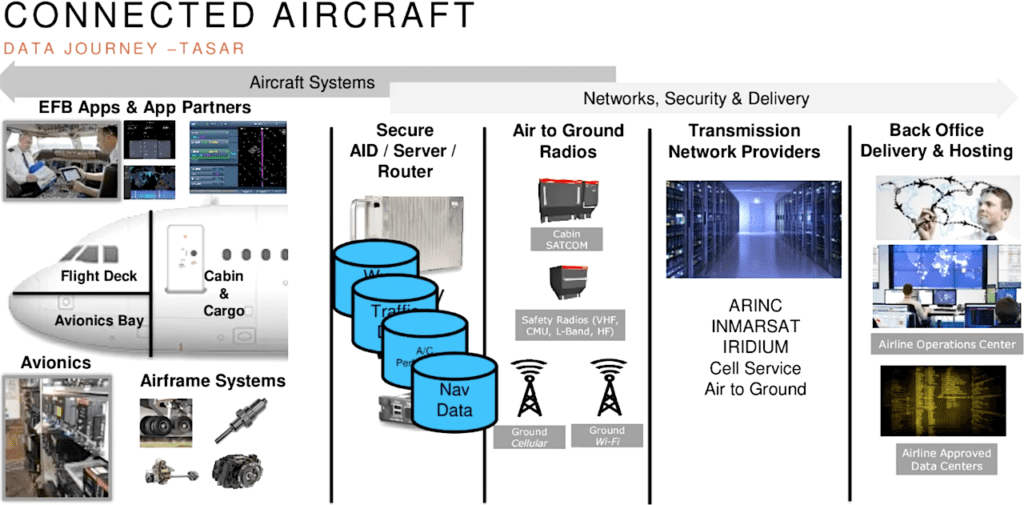
During the recent “Connected ROI: Aircraft Interface Device” Global Connected Aircraft Cabin Chats session, Collins Aerospace provided an overview of how aircraft interface devices have become central to the flow of data between off and onboard systems and applications. Photo: Collins Aerospace
Avionics and aircraft manufacturers are expanding the scope and capability set of aircraft interface devices (AID), which have become a key technology within modern connected aircraft networks, according to presentations given by experts from Bombardier and Collins Aerospace during a panel featured as part of last week’s Global Connected Cabin Chats web series.
Early adoption of AID technology primarily served the purpose of providing some basic electronic flight bag (EFB) functionality, along with acquisition and transmission of flight and maintenance operations quality assurance data, according to Jason Marmur, business development manager for Collins Aerospace. However, new capabilities are being unlocked as more aircraft operators adopt them and customize them to their flight operational and maintenance needs.
“If you actually look at everything an AID is capable of providing to your operation, you can see there is so much more that it can do,” Marmur said during the “Connected ROI: Aircraft Interface Devices” Cabin Chats session. “Aircraft health data, weather data from the ground, cabin data, navigation database uploads, trajectory based operations and advanced EFB applications like flight profile optimization, can also be enabled with AIDs.”
The expansion in functionality of the AID as it is known today in the avionics industry will continue to be driven by its use of the ARINC 834 standard, which serves as a data communication protocol, or interface, between certified avionics systems and non-certified tablet EFBs, according to Marmur. Using ARINC 834, an AID can provide a subscription-based EFB application with access to aircraft data parameters in both read and write mode. In this way, it can also access all of the ARINC 717 data that airlines are required to capture and record in flight data recorders.
“Today’s AID technology has a number of ARINC 429, 717 discrete Ethernet connections, so you make one 429 connection to your [multimode receiver] MMR, your GPS system, another one to the [flight management computer] FMC, and yet another discrete to the weight on wheels to know when to enable wireless for example. As far as our implementation goes at Collins, we provide a software development kit to help determine what data needs to be recorded and where it needs to be sent. This is how the use cases for AIDs will continue to expand beyond what they were thought to be in their earliest days,” Marmur said.
The number of AIDs and associated applications and technologies available from avionics suppliers has expanded in recent years as well. Collins, for example, provides its InteliSight electronic flight folder, designed to give users the ability to do flight planning, performance tracking and access to weather data with real time updates. The company’s Secure Server Router (SSR-7000) Electronic Flight Bag Interface and Communication Unit (EICU) also features an embedded router capable of wirelessly connecting EFB applications to onboard aircraft and external connectivity networks, and has a built-in AID.

Boeing describes its software-configurable AID as featuring two wireless wide area networks—802.11, one 4G LTE cellular radio and two SIM cards. Photo: Boeing
Astronics has also had its own webFB AID available for several years, serving as a communications bridge between Boeing 737NG ARINC 429 and 717 data feeds and wireless EFB applications. Boeing, through the avionics division it created in 2018, also introduced a software-configurable AID last year as standard on all new in-production commercial airplane models. Honeywell Aerospace introduced its aircraft data gateway in 2017 that also provides the type of AID functionality discussed throughout the Cabin Chats session.
Teledyne is another supplier of AIDs that has continuously expanded the technology’s capabilities in recent years, including a 2019 partnership with Viasat that enables the use of satellite-based connectivity to stream Aircraft Communications Addressing and Reporting System (ACARS) messages in real-time.
Avionica has also become well known for the continued growth in deployment and functionality for its interface device technology. Bombardier is in the process of adding Avionica’s aviONS technology as a free upgrade to all of its in-service aircraft, under its Smart Link Plus upgrade program first launched at the 2019 NBAA Business Aviation Convention and Exhibition (BACE). Their goal with the upgrade program is to give owners of older Challengers and Learjet models the opportunity to access their flight and maintenance data faster and in a way that is customized to their specific flight operational structure.
 | Want to hear more on aircraft connectivity applications? Check out the Global Connected Aircraft Podcast, where Avionics editor-in-chief Woodrow Bellamy III interviews airlines and industry influencers on how they’re applying connectivity solutions. |
Mike Blackman, connected aircraft business strategy and services specialist for Bombardier Business Aircraft, believes one of the next changes coming to how interface device technology works within aircraft is the business model associated with the various types of services that can be enabled and managed using an AID.
“The models are evolving, if you put this device on your aircraft, some of us become your TV service provider you have a box and then you pay for the services that you’re going to use,” Blackman said during the Cabin Chats series question and answer session. “There has to be some kind of service subscription around it, because there are more services you can get based on what you’d like to do, on an aircraft level we want to improve performance and maintenance, that’s a basic level, but the business model it is a subscription type service.”